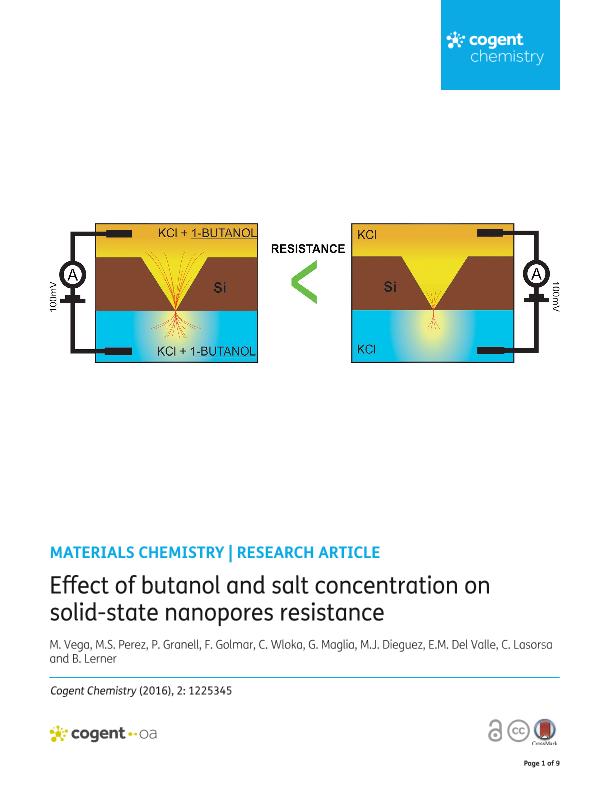Mostrar el registro sencillo del ítem
dc.contributor.author
Vega, M.
dc.contributor.author
Perez, Maximiliano Sebastian

dc.contributor.author
Granell, Pablo Nicolás

dc.contributor.author
Golmar, Federico

dc.contributor.author
Wloka, C.
dc.contributor.author
Maglia, G.
dc.contributor.author
Dieguez, M.J.
dc.contributor.author
Del Valle, E.M.
dc.contributor.author
Lasorsa, Carlos Alberto

dc.contributor.author
Lerner, Betiana

dc.date.available
2020-10-13T14:11:04Z
dc.date.issued
2016-09
dc.identifier.citation
Vega, M.; Perez, Maximiliano Sebastian; Granell, Pablo Nicolás; Golmar, Federico; Wloka, C.; et al.; Effect of butanol and salt concentration on solid-state nanopores resistance; Cogent OA; Cogent Chemistry; 2; 532; 9-2016; 1-9
dc.identifier.issn
2331-2009
dc.identifier.uri
http://hdl.handle.net/11336/115756
dc.description.abstract
The objective of this study was to demonstrate the possibility of using 1-butanol to detect in a reliable way the open pore current of pyramidal solid-state nanopores produced in silicon wafers. The nanopores were produced through controlled pore formation by neutralizing an etchant (KOH) with a strong acid (HCl). Since nanopores produced by this method have a larger depth than those made in nanometer thick membranes, they behave as nanochannels. As a consequence, the open pore current detection is more challenging. Thus, we report that low amounts of butanol considerably aid in the detection of the open pore current of nanopores.
dc.format
application/pdf
dc.language.iso
eng
dc.publisher
Cogent OA
dc.rights
info:eu-repo/semantics/openAccess
dc.rights.uri
https://creativecommons.org/licenses/by/2.5/ar/
dc.subject
SOLID STATE NANOPORES
dc.subject
SILICON WAFER
dc.subject
RESISTANCE
dc.subject
BUTANOL
dc.subject.classification
Otras Nanotecnología

dc.subject.classification
Nanotecnología

dc.subject.classification
INGENIERÍAS Y TECNOLOGÍAS

dc.title
Effect of butanol and salt concentration on solid-state nanopores resistance
dc.type
info:eu-repo/semantics/article
dc.type
info:ar-repo/semantics/artículo
dc.type
info:eu-repo/semantics/publishedVersion
dc.date.updated
2020-10-09T15:59:12Z
dc.journal.volume
2
dc.journal.number
532
dc.journal.pagination
1-9
dc.journal.pais
Reino Unido

dc.description.fil
Fil: Vega, M.. Universidad Tecnológica Nacional. Facultad Regional Haedo; Argentina
dc.description.fil
Fil: Perez, Maximiliano Sebastian. Universidad Tecnológica Nacional. Facultad Regional Haedo; Argentina. Consejo Nacional de Investigaciones Científicas y Técnicas; Argentina
dc.description.fil
Fil: Granell, Pablo Nicolás. Consejo Nacional de Investigaciones Científicas y Técnicas; Argentina
dc.description.fil
Fil: Golmar, Federico. Consejo Nacional de Investigaciones Científicas y Técnicas; Argentina
dc.description.fil
Fil: Wloka, C.. University of Groningen; Países Bajos
dc.description.fil
Fil: Maglia, G.. University of Groningen; Países Bajos
dc.description.fil
Fil: Dieguez, M.J.. Instituto Nacional de Tecnología Agropecuaria; Argentina
dc.description.fil
Fil: Del Valle, E.M.. Universidad de Salamanca; España
dc.description.fil
Fil: Lasorsa, Carlos Alberto. Universidad Tecnológica Nacional. Facultad Regional Haedo; Argentina
dc.description.fil
Fil: Lerner, Betiana. Universidad Tecnológica Nacional. Facultad Regional Haedo; Argentina. Consejo Nacional de Investigaciones Científicas y Técnicas; Argentina
dc.journal.title
Cogent Chemistry
dc.relation.alternativeid
info:eu-repo/semantics/altIdentifier/url/https://www.cogentoa.com/article/10.1080/23312009.2016.1225345
dc.relation.alternativeid
info:eu-repo/semantics/altIdentifier/doi/http://dx.doi.org/10.1080/23312009.2016.1225345
Archivos asociados
